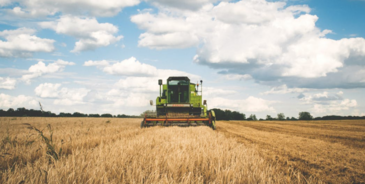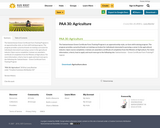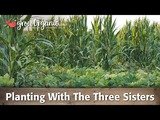
This video compares practices used in conventional and organic farming productions.
- Subject:
- Agriculture Production
- Agriculture Studies
- Material Type:
- Open Access Asset
- Author:
- Grain Farmers of Ontario
- Date Added:
- 06/24/2024

This is a collection of resources for teaching and learning about Agriculutral Education.

This video compares practices used in conventional and organic farming productions.

The Saskatchewan Green Certificate Farm Training Program is an apprenticeship-style, on-farm skill training program. The program provides a practical hands-on training curriculum for individuals interested in pursuing a career in the agricultural industry. Upon course completion, trainees are awarded a certificate of completion from the Ministry of Agriculture. For more information, criteria, how to apply and much more go to the following site: Saskatchewan – Green Certificate Farm Training Program

This video outlines the importance of using eye protection when working. It outlines the most common activities when eye injuries happen. This video would be helpful in a PAA class when learning about worker safety or in the farm safety sections of agriculture-related courses.
The GotSafety Youtube channel also offers these videos in Spanish.

In this video, common types of PPE are tested to see how they can protect from projectiles, falling objects, and other possible hazards. This is an entertaining take on Personal Protective Equipment and how it protects people.

To identify the male and female structures of the flower, recognize their function in reproduction, and differentiate between perfect and imperfect flowers.

The following is a list of picture books that teachers can reference when looking for books to use in the classroom that will infuse agriculture into lessons they're already teaching. These books would be very useful to teach a variety of reading strategies and comprehension tools with such as making connections, predicting, and determining author's purpose.

This lesson focuses on the many professions within the Agriculture and Food sector. Students will gain an appreciation and knowledge of the multitude of professions that exist within the Agriculture and Food sectors, while also understanding the importance of everyday food production and sustainability to the global population. Available in French "Planet X: Opportunités « extra-terrestres » dans le domaine agroalimentaire".

CropLife/ASTA Video on plant breeding and its many milestones.

Students will show that plants grow more successfully in fertile soil when compared to other materials.

Students will learn plant, seed, and flower parts and their functions.

Where do plants get their food from? Remember they are autotrophic, plants make their own food through the process of photosynthesis. In order to make all of the macromolecules, the plant needs to obtain some other elements from the soil. For example, Nitrogen is needed to make protein. As you know Nitrogen is needed to make protein, so without this element the plant will have stunted growth.

"Canadians have more choices and pay some of the lowest prices in the world for FOOD — thanks in part to the plant science technologies farmers use, from pesticides to plant biotechnology."
Use this resource to learn more about food.

Both plant and animal proteins are associated with health benefits and drawbacks. But you may be wondering what the difference is between the two. This video breaks down both types of protein and their benefits.

The Three Sisters, developed by Native Americans, is one of the earliest examples of companion planting.

This mini unit plan is taken right from Ag in the classroom. Lesson plans and handouts are included. Topics discussed include, food waste, soil science, plant biology, and climate change.

We truly are lucky here in Canada to enjoy many different food choices for our diets. Questions do arise on different proteins we consume: how much is enough, what do we need and are plant and animal-based proteins the same? Long-time dietitian and mother, Carol Harrison, answers these questions through a fun and meaningful dialogue about how meat protein is structured differently than plant protein. She also includes some tips on how to extend your meat budget a bit more.

The film explores the origins of regenerative agriculture, offering a story that is both new and ancient in its roots. Co-written and narrated by Lyla June Johnston, an Indigenous public speaker, artist, scholar, and community organizer, the film takes a holistic approach to regenerative stewardship, expanding the idea of regeneration beyond the principles popularized in the relatively young regenerative agriculture movement.
This educational, animated short film is designed to inspire individuals to take action around regenerative agriculture and climate change. Audiences are left to answer one of the most pressing questions of our time: if we expand the regenerative mindset beyond farming, what else is possible?

Precision agriculture (PA), satellite farming, or site-specific crop management (SSCM) is a farming management concept based on observing, measuring, and responding to inter and intra-field variability in crops.

For many farmers, their tractor is the most important piece of equipment in the shed. But tractors can be very dangerous if not used safely. Did you know that getting run over by a tractor is the leading cause of death on Canadian farms? Watch this video to learn how to identify ways to keep yourself and others safe while working with tractors.

Agricultural producers face risks from sun up to sun down (and sometimes beyond). Injuries can seriously impact their livelihood. It is important to think proactively and reduce risk before accidents happen. Four of the leading categories of farm accidents are:
- transportation
- farm equipment
- work environment
- chemical handling incidents.